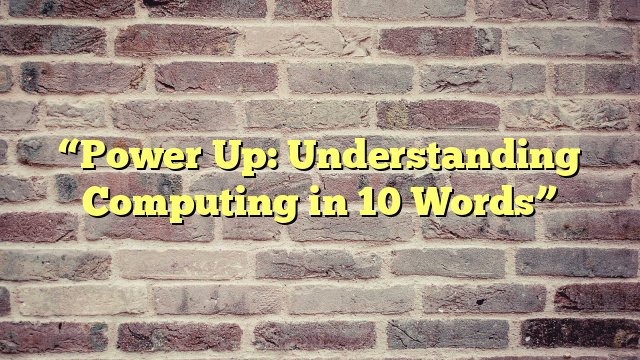Introduction:
Computing has become an integral part of our daily lives, powering almost every aspect of our society. From smartphones to supercomputers, it plays a crucial role in how we work, communicate, and entertain ourselves. But for many people, the world of computing can be overwhelming, with technical jargon and complex concepts. In this article, we will break down the fundamentals of computing into 10 simple words, making it easier for anyone to understand and appreciate the power of this field.
1. What is Computing?
Computing, in simple terms, is the use of computers to process and store information. It involves using hardware (physical components like processors, memory, and storage devices) and software (programs and applications) to perform specific tasks. Computing has evolved significantly over the years, from the big room-sized machines of the past to the compact and powerful devices we use today.
2. Hardware:
Hardware refers to the physical components of a computer system, including the central processing unit (CPU), memory, hard drive, and input/output devices (such as a keyboard and mouse). These components work together to process data and carry out instructions. The speed and performance of a computer depend on the quality and specifications of its hardware.
3. Software:
Software is the set of instructions that tell a computer what to do. It includes operating systems, applications, and programs. Operating systems, such as Windows, MacOS, and Linux, control the hardware and manage the computer’s resources. Applications, on the other hand, are programs designed to perform specific tasks, such as word processing, gaming, or photo editing.
4. Algorithms:
An algorithm is a set of step-by-step instructions or rules used to solve a problem or complete a task. It is the foundation of computing and is used in various fields, including mathematics, computer science, and artificial intelligence. For example, when you search for something on the internet, the search engine uses an algorithm to find the most relevant results.
5. Coding:
Coding, also known as programming, is the process of creating instructions for a computer to execute. It involves writing lines of code using programming languages such as Java, Python, or C++. These codes tell the computer what to do and how to do it. Learning to code is essential for anyone looking to pursue a career in computing.
6. Data:
Data is information in the form of numbers, text, images, or any other type of input. It is the fuel that drives computing, as computers process and store data to carry out tasks. With the rise of the internet and social media, we are generating massive amounts of data every day. This data is used for various purposes, such as market research, personalized advertising, and machine learning.
7. Cybersecurity:
With the increasing use of computers, the threat of cyber-attacks has also risen. Cybersecurity is the practice of protecting computer systems and networks from digital attacks, theft, and damage. It includes measures such as firewalls, antivirus software, and data encryption to ensure the safety and privacy of data. As we become more reliant on technology, cybersecurity is becoming a critical aspect of computing.
8. Cloud Computing:
Cloud computing is the delivery of computing services over the internet. It allows users to access data and applications remotely, without the need for physical storage or processing power. Services such as Dropbox, Google Drive, and Microsoft Office 365 are examples of cloud computing. It has revolutionized the way we store and access data, making it more convenient and cost-effective.
9. Artificial Intelligence (AI):
Artificial Intelligence (AI) is the development of computer systems that can perform tasks that typically require human intelligence. It involves the use of algorithms and data to train machines to think and act like humans. AI is being used in various fields, such as healthcare, finance, and transportation, to automate processes, and improve efficiency.
10. Internet of Things (IoT):
The Internet of Things (IoT) is the interconnection of devices and everyday objects through the internet. These devices can collect and exchange data, making our lives more convenient and efficient. For example, smart home devices, such as thermostats and security systems, can be controlled remotely through the internet. IoT is a rapidly growing field, with an estimated 41.6 billion connected devices by 2025.
Conclusion:
In just 10 words, we have covered the basics of computing, from hardware and software to AI and IoT. Understanding these concepts is crucial in today’s digital world, as computing continues to shape and influence our daily lives. By breaking down complex terms into simpler ones, we hope to have made computing more accessible and less daunting for everyone. So, the next time you use your computer or smartphone, remember the power of these 10 words that make it all possible.

